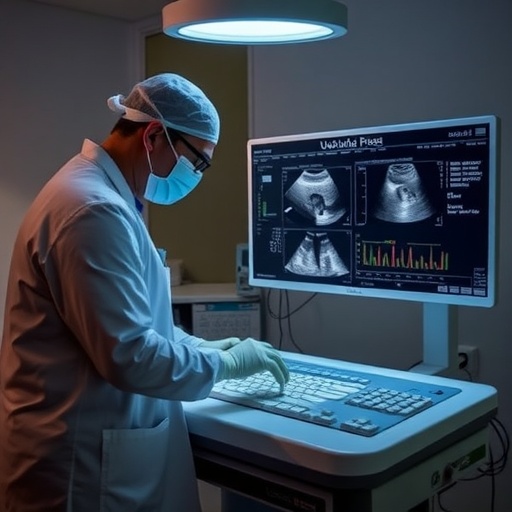
In the rapidly evolving landscape of medical diagnostics, the effective utilization of advanced health technologies remains a pivotal challenge. A new study emerging from China sheds light on the intricate mechanisms that govern how clinicians adopt and integrate Contrast-Enhanced Ultrasound (CEUS) into their practice, revealing a layered and dynamic pathway that can potentially transform how health innovations spread and mature within clinical environments.
At the heart of the research lies the notion that medical technologies are not merely static tools but complex knowledge products whose utility evolves as clinicians develop deeper understanding and more nuanced applications. CEUS, a technology enhancing the imaging of vascular structures and lesions through ultrasound contrast agents, has demonstrated immense potential in liver disease diagnostics, yet its adoption has been uneven and suboptimal across various clinical settings. This study sought to decode the facilitators and latent processes that encourage clinicians to climb what the authors term the “ladder” of technology utilization.
Conducted across two Chinese provinces, Jiangxi and Fujian, the investigation engaged nearly 300 clinicians specializing in liver disease-related departments. These frontline professionals were surveyed rigorously through a structured questionnaire designed to probe their interaction with CEUS at multiple cognitive and practical levels. By leveraging robust multilevel regression analyses alongside structural equation modeling, the researchers unpacked critical environmental, organizational, and individual factors shaping CEUS usage.
.adsslot_wic9J3vDfl{ width:728px !important; height:90px !important; }
@media (max-width:1199px) { .adsslot_wic9J3vDfl{ width:468px !important; height:60px !important; } }
@media (max-width:767px) { .adsslot_wic9J3vDfl{ width:320px !important; height:50px !important; } }
ADVERTISEMENT
A defining feature of the study is its classification of technology utilization into three hierarchical tiers: symbolic, conceptual, and instrumental. Symbolic utilization refers to clinicians’ awareness and acceptance of CEUS as an innovative tool, albeit with limited application. Conceptual utilization reflects deeper comprehension—where practitioners internalize the technology’s principles and potential scope. Instrumental utilization represents the highest tier, where CEUS is proficiently and routinely employed in diagnoses and treatment decisions, effectively impacting patient outcomes.
The findings reveal a compelling interaction among these tiers, illustrating a cascading mechanism where symbolic acceptance fosters conceptual understanding, which in turn drives practical application. Such progression is not automatic; it hinges on a confluence of external and internal stimuli within the healthcare ecosystem. Market pressure and organizational support emerged as potent influencers at the symbolic level, underscoring how institutional endorsement and competitive dynamics motivate clinicians to initially adopt CEUS.
Conceptual utilization was significantly swayed by subjective norms, organizational support, and interestingly, negatively correlated with certain facets of organizational culture. This dichotomy suggests that while shared expectations and backing facilitate cognitive engagement with CEUS, entrenched cultural elements within hospitals might sometimes impede deeper learning or openness to innovation. Navigating these cultural barriers is essential in fostering an environment conducive to technological advancement.
At the instrumental level, perceived ease of use stood out as a crucial determinant. Clinicians who found CEUS user-friendly were more likely to incorporate it into their daily diagnostic repertoire. This highlights the importance of designing technologies that align with clinical workflows and the pressing need for targeted training to ease the transition from theory to practice. The significant statistical relationships identified confirm that advancing through these stages demands a holistic approach addressing both software and human factors.
Beyond detailing these relationships, the study propounds a dynamic theoretical model elucidating how different facilitators interact over time to promote upward mobility in technology utilization. By conceptualizing this ‘ladder,’ it offers a strategic framework for healthcare administrators and policymakers aiming to accelerate dissemination and integration of not only CEUS but potentially other emergent health technologies.
The implications of this research are multifaceted. For clinicians, understanding the trajectory of technology adoption can foster self-awareness and proactive learning behaviors, encouraging them to seek out resources and institutional support to master innovative tools. For hospital managers, the findings underscore the necessity of cultivating an organizational climate that balances stability with adaptability, promoting robust support structures and constructive cultural evolution.
Furthermore, the study underscores the significance of external market forces, reflecting the often-underappreciated role of healthcare ecosystems beyond individual institutions. Competitive pressures and policy incentives can serve as catalysts, stimulating hospitals and their staff to embrace cutting-edge diagnostic tools. This interplay suggests that comprehensive strategies spanning policy, market regulation, and institutional culture are crucial to fostering widespread technology adoption.
This nuanced exploration of CEUS utilization encapsulates a broader dialogue on the diffusion of innovation within healthcare—a domain where delays in technology uptake can translate into missed opportunities for improved patient outcomes. By dissecting the layered processes and conditional factors that facilitate or hinder technology use, the study invites a paradigm shift from simplistic diffusion models toward dynamic, multi-level understandings that mirror clinical realities.
In essence, the research not only spotlights CEUS as a case study but also contributes substantively to the field of implementation science, providing empirical evidence backed by rigorous statistical modeling. It serves as a clarion call to integrate organizational sociology, behavioral psychology, and technological design into cohesive strategies for health innovation promotion.
Looking forward, the authors advocate for targeted interventions derived from their model, including enhancing organizational support systems, tailoring training programs to ameliorate ease of use, and fostering cultural transformations aligned with innovation acceptance. Such recommendations hold the promise of significantly improving the efficiency and effectiveness of diagnostic processes, especially in regions grappling with uneven access to cutting-edge medical technologies.
This research also sets the stage for future inquiries exploring longitudinal dynamics of technology utilization, cross-cultural variations, and the impact of emerging artificial intelligence integrations with CEUS. As global health systems strive for precision medicine and personalized care, understanding the human and systemic factors influencing technology adoption will be pivotal.
Ultimately, by illuminating the facilitators and mechanisms driving the adoption of contrast-enhanced ultrasound within China’s liver disease clinical context, this study offers a replicable template for advancing health technology utilization globally. It merges theoretical innovation with practical insights, reinforcing the notion that climbing the ladder of health technology is a nuanced journey shaped by complex interdependencies rather than a straightforward leap.
The study’s robust methodology, comprehensive scope, and rich theoretical contributions position it as a seminal work, likely to influence policymakers, healthcare leaders, and researchers dedicated to bridging gaps between technology development and clinical application. As medical innovation accelerates, such research provides essential guidance for embedding new tools firmly within healthcare delivery, enhancing disease diagnosis, and ultimately saving lives.
Subject of Research:
Clinicians’ utilization of Contrast-Enhanced Ultrasound (CEUS) and the facilitators influencing different levels of health technology adoption in China.
Article Title:
Climbing the ladder of health technology utilization: facilitators and dynamic mechanism of clinicians’ contrast-enhanced ultrasound utilization in China.
Article References:
Zheng, Y., Chen, Y., Wu, S. et al. Climbing the ladder of health technology utilization: facilitators and dynamic mechanism of clinicians’ contrast-enhanced ultrasound utilization in China. BMC Cancer 25, 1142 (2025). https://doi.org/10.1186/s12885-025-14537-7
Image Credits:
Scienmag.com
DOI:
https://doi.org/10.1186/s12885-025-14537-7
Tags: CEUS clinician survey studyclinical practice transformationclinician technology integrationcontrast-enhanced ultrasound benefitsenhancing ultrasound imaging techniquesfactors influencing ultrasound adoptionhealthcare technology utilization barriersimproving diagnostic methods in healthcareliver disease imaging advancementsmedical diagnostics innovationsmedical technology knowledge evolutionultrasound technology adoption



